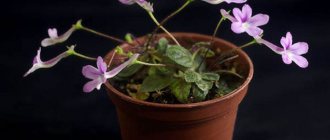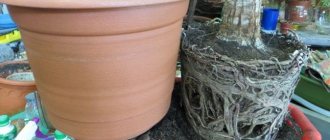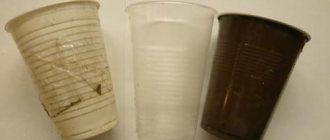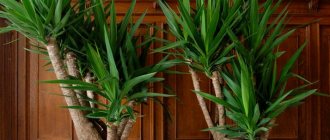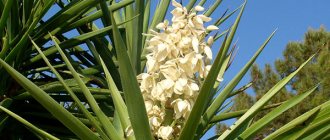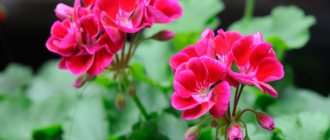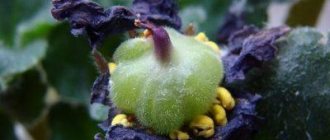Beginning gardeners can easily propagate yucca on their own using one of the vegetative methods. For an outdoor plant, it is easiest to plant daughter rosettes; for an indoor plant, it is customary to take cuttings; there are other methods that give a high percentage of rooting. The main thing when growing a crop is to choose the right time and make straight, even cuts.
You can propagate yucca at home using seeds, but the method is complicated and unreliable. It is used by breeders when developing new varieties, by amateurs as an experiment, or when they do not know what they are facing.
How to propagate and root yucca?
Young offspring are most often obtained from an adult healthy plant. Already in the first years of cultivation, with proper care, a false palm tree can produce several shoots. Cuttings are rooted in water or wet sand. You can use expanded clay or specially formulated soil.
Components for soil mixture:
- washed sand - 1 part;
- humus (preferably leafy) - 0.5 parts;
- turf soil - 1 part.
Ready-made soil for rooting cuttings can be purchased at the store.
A plant planted in the ground forms its first roots within two months.
Experts recommend propagating indoor palm trees using one of the following methods:
- trunk parts;
- air layering;
- cut off top;
- offspring;
- seeds.
Vegetative propagation begins in April-May. This is a period of active growth for yucca, so rooting goes especially well. Separation of offspring is also best done in spring and summer or during transplantation of an adult bush.
Yucca at home
It turns out that yucca, which we often confuse with a palm tree, has nothing in common with this tropical plant. It is an evergreen, tree-like plant belonging to the Asparagus family and has many varieties. This crop came to us from Mexico and Central America.
Yucca - or false palm as it is also called - is easy to propagate and grow. It grows well in southern and eastern windows and requires low temperatures in winter.
This is interesting. In Southern Europe, Yucca filberta grows well in open spaces. It can easily withstand short-term temperature drops to -10 ... -15 °C.
The woody stem ends in a tuft of lanceolate leaves. Some species have an initially branched stem. In indoor conditions, the plant produces white, bell-shaped buds. When grown indoors it does not bloom.
Yucca aloifolia and Yucca elephantips are usually grown indoors. We'll look at them below.
In stores you can buy ready-made soil for rooting cuttings.
Reproduction by apex
From an adult plant, about 10-15 cm of the stem with the apical leaf rosette is cut off. The cut areas are treated with wood ash or crushed coal. The top stem is dried for 2-3 hours. Rooted in three ways:
- in wet sand, perlite, vermiculite;
- in a nutrient substrate (as for seeds);
- in warm boiled water with an activated carbon tablet.
Place a transparent bag over the container with the apical segment and place it in a shaded place with a temperature of about +20C. Water as needed to prevent the sand or substrate from drying out. The bag is removed for 30 minutes every day. At this time, the foliage is sprayed with a solution of fertilizers for succulents, and rotten leaves are removed.
After 1.5-2 months, roots will appear. The yucca is replanted, the pot with the plant is left in the shade for 2-3 days and then transferred to a sunny corner.
Propagation by cuttings
Part of the stem is sawed off and divided into several parts up to 20 cm long. The sections are disinfected. The cuttings are dried in the fresh air for 2-3 hours.
Work order:
- Pots or a deep container are filled with a mixture of sand and peat (1:1).
- The lower end of the cutting is buried 3-5 cm into the moist substrate. It is convenient to use pots here. The second option is to place the cuttings horizontally in a container. They are lightly pressed into the substrate, but not covered on top.
- The pots are covered with transparent bags or plastic balloons. The containers are covered with film.
- Greenhouses are placed in the shade, ventilated daily, and maintain moderate substrate humidity and a temperature of about +20C.
- With the appearance of buds, the shelter is removed, and the plant is fed with any nitrogen fertilizer.
- After 2 months, the yucca is transplanted. Horizontal petioles are first divided into parts according to the number of sprouts. Each part is placed in a separate pot.
Reproduction by shoots
Root and stem shoots are suitable for propagation. It is more convenient to root sprouts in water. An activated carbon tablet will prevent rotting. Fresh aloe juice stimulates root growth (5-7 drops per 200 ml). Add water as needed or change it when it becomes cloudy.
Shoots can be rooted in wet sand, perlite and nutrient substrate. They are buried 1-3 cm and create a greenhouse effect. Standard care: daily ventilation, maintaining optimal humidity and temperature. When roots appear, the plants are replanted.
Propagation by seeds
Yucca blooming indoors is a rare occurrence. In nature, the plant is pollinated by a symbiont insect (yucca moth). At home, seed pods do not form. Flower growers buy ready-made seeds (3-5 pieces per package). The seeds have a dense, glossy black shell. The average seed size is about 5 mm. Without pre-treatment they germinate in a month.
Work order:
- Suitable containers are small pots, a tall plastic container with drainage holes.
- The nutrient substrate is a mixture of turf (2) and coniferous (2) soil with coarse sand (2) and humus (1). Ready-made soil for succulents or palm trees is suitable.
- Scarification of seeds will reduce the germination period to 2 weeks - their shells are slightly ground off with sandpaper and kept in a growth stimulator for a day.
- A centimeter layer of drainage is poured into the container and filled with soil. The seeds are buried 5 mm into moist soil.
- The container is closed with a lid or covered with film. The greenhouse maintains moderate soil moisture, the temperature is not lower than +25C and is ventilated daily.
- When the first leaf develops, the seedlings are planted in separate pots with a volume of up to 100 ml. After the formation of 5 full leaves, the yucca is transplanted into a container 2 cm wider than the volume of the root system.
Substrate requirements
You can purchase a nutrient substrate at any specialized gardening store or prepare it yourself. The most important thing is that it is loose and has a good flow of air and water to the roots. Substrate for palm trees, succulents, dracaenas and other plants can be used from commercially available mixtures.
Yucca prefers soil with a neutral pH of 5-7. For this reason, at home, the soil should consist of coarse river sand, turf, leaf soil and humus, in approximately equal proportions. Young plants can be given black soil and peat; for older plants there is no need to add humus.
Pour the soil into a large, tall pot and make drainage - crushed stone, expanded clay, broken brick or clay fragments. Then add a layer of soil 4-6 cm thick and place the plant in the pot. Do not immerse the plant to a depth of more than 3 cm.
If the cuttings purchased from the grower are not marked with wax, root them as described above, laying them horizontally on the ground and separating the resulting shoots.
Reproduction by air layering
This method will help preserve the healthy part of the dying yucca. Work order:
- The trunk is stripped of bark around its circumference, with a strip of 1-1.5 cm. If the plant is sick, the bark is removed 10 cm above the affected area.
- The area where the bark is cut is wrapped in a layer of damp sphagnum moss, covered with film and fixed.
- In addition to regular care, make sure that the moss does not dry out.
- After a month, check the degree of root development. They should be strong, from 2 to 5 cm long.
- The cuttings are separated from the mother bush and rooted in the ground.
Common types
As noted above, about thirty varieties of yucca are known, some of which are grown as indoor plants. The most popular are:
- Yucca elephant. Caring for the plant at home will not cause any special problems, since it is highly unpretentious and has strong immunity. The table is powerful and can reach a height of up to 1.5 meters. The leaves are palm-shaped and grow up to 75 centimeters in length.
- Aloe leaf yucca. A perennial plant with erect shoots and a spherical lush crown. A characteristic feature of the species is its olive elliptical-lanceolate leaves, arranged in a spiral on the trunk. Their length can reach 55 centimeters.
- Filamentous yucca. A unique variety with virtually no stem. Its long, pointed leaves grow directly from the roots. The rhizome is well developed and deeply buried in the ground, thanks to which the shrubs can withstand even severe frosts, which greatly simplifies caring for yucca at home. The leaves, with a sharply pointed soft or hard tip, are blue-green in color and complex in shape, and reach a length of 70 centimeters.
- Blue yucca. This variety has no stems completely. The leaves are linear, with sparse, thin, curled threads along the edges, have a bluish-green color and grow up to 70 centimeters.
Yucca (care and replanting at home will be described in detail below) is a perennial plant that differs from other members of the family in its high endurance and good health. Its cultivation does not cause any special problems, so even novice flower growers can cope with everything. With a little effort, you can grow an incredibly beautiful exotic plant that will diversify your interior and make it more comfortable and attractive.
Reproduction by offspring
With proper care, yucca can have children in the first year of life. Separating root or stem shoots from a false palm tree is even useful - for normal growth and development, you need to ensure that there are no more than five shoots on the plant at the same time.
The process of rooting children is as follows:
- It is advisable to sprinkle the cuts on the parent tree and on the offspring itself with crushed charcoal;
- separated offspring must be planted in containers with damp, clean sand, watered and covered with a glass jar or plastic bag;
- It doesn’t hurt to provide young plants with good humidity and a temperature of at least 20 °C;
- it is very important to ventilate the “greenhouse” daily and water the plant as needed;
- root formation will occur in a period of approximately two months;
When the yucca has taken root, you need to transplant it into a permanent pot with good soil and pieces of charcoal in it.
Optimal timing for reproduction
Seed propagation is carried out immediately after collecting the seeds, since they quickly lose their ability to germinate. Vegetative propagation is carried out from April to June. In the spring, during the period of active growth, cuttings and apical shoots take root well. Separation of offspring is carried out both in spring and summer if it is necessary to replant the plant.
Basic requirements for capacity:
- the presence of holes for water drainage;
- volume corresponding to the size of the root system.
When can you replant yucca?
Yucca can be replanted throughout the active growing season - from early spring to late autumn. However, yucca adapts to new conditions most quickly if the procedure is carried out in early or mid-spring.
At this time, plant organisms experience the most active metabolism, which directly has a beneficial effect on rooting in new soil.
Also find out why yucca leaves turn yellow.
Growers often have differing opinions regarding replanting new plants. Many people advise carrying out the procedure within a few days after purchasing yucca. Otherwise, poor-quality soil or the wrong size of the container can inhibit its growth and immunity, in which case the flower cannot avoid all kinds of infections.
Opponents argue that placing a palm tree in new climatic conditions already causes stress for it, so the procedure should be held off until spring.
It is also worth mentioning that you should definitely replant a palm tree that is susceptible to any infectious diseases or pest damage. In this case, the procedure is carried out urgently, regardless of age and time of year. During an emergency change of container, the soil is also renewed.
Important! It is not recommended to replant yucca more than 3 times in a year, otherwise it can lead to disease and even death of the plant.
Care after breeding
Further care consists of standard procedures for indoor plants. Care rules:
- Watering - young plants are watered in small portions, not allowing the top layer of soil to dry out. Adult specimens are watered once a week in the warm season, and once every 2-3 weeks in the autumn-winter season. Experienced gardeners recommend calculating the amount of moisture based on the volume of soil - 1 liter of water per 4 liters of soil. Excess moisture is drained from the pan to prevent rotting of the roots. In the summer, to wash away dust from the foliage, bathe the plant once a month under a warm shower.
- Feeding is carried out in the spring and summer. For fertilizer, special liquid formulations for palm trees are used, for example, “Stimovit”. The drug is diluted with water in a proportion twice as large as indicated in the instructions. Apply once every 2-3 weeks, spraying the green part.
- Pruning - formative pruning is carried out after the yucca leaves the dormant period. You can trim an adult plant whose trunk diameter is at least 2 cm. Pruning is carried out with pruning shears at a distance of 40 cm from the soil surface. The cut is treated with crushed coal and filled with wax to prevent rotting. The procedure stimulates the formation of lateral shoots and creates growth in several trunks.
- Transplantation - young plants are replanted annually, adults - once every 3-4 years. The procedure is carried out in the spring using the transshipment method.
For a month, the yucca is not disturbed by care procedures (except for watering): it must take root and adapt.
Transfer
To ensure that your favorite plant feels comfortable over time, replant it periodically (every 2-3 years). The best time for this is spring, although it can be done at other times of the year.
Before replanting the plant, remove all dried leaves. Care for the plant and be careful not to damage its roots, as this can cause illness or even death.
Choosing a new pot is very important. There are a few important points to keep in mind:
- The diameter of the new pot should be 4-5 cm larger than the diameter of the rhizome.
- Select a pot with a depth to internal diameter ratio of 2:1.
- Choose a pot made of durable material that will not warp when filled and planted.
Before transplanting, the bottom of the pot should be lined with a layer of drainage material. Then fill the pot with new soil.
You can also replant the plant along with the substrate and simply fill the remaining space with soil. However, this can only be done if the old soil is not yet sterilized and contains sufficient minerals.
When backfilling, make sure there are no air pockets left. When finished, water the pot of yucca.
Rooting the top or dividing the rhizome will quickly produce a large young plant. . If propagated by division, one specimen can produce several small ones.


